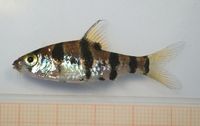Foersch's Fire Barb (Desmopuntius foerschi)
From The Aquarium Wiki
Foersch's Fire Barb
Desmopuntius foerschi
95 Litres (25 US G.)
5-6 cm (2-2.4")
Freshwater
4.0 - 7.0
22.8-27.8°C (73 -82 °F)
1-10 °d
1:2 M:F
5-8 years
Family
Cyprinidae
Contents
Additional names
- Foersch's Fire Barb, Boomerang Barb, Giant Sixbanded Barb
Additional scientific names
- Barbus foerschi, Puntius foerschi
Origin[edit]
- Appears to be native to the Indonesian provinces of Kalimantan Timur (East Kalimantan) and Kalimantan Tengah (Central Kalimantan) on the island of Borneo although information is quite scarce. Type locality is ‘About 50 to 100 kilometers north of Sampit, Kalimantan, Indonesia’, which presumably refers to the Sampit (aka Mentaya) River basin while the only other details we’ve been able to obtain suggest that it’s also been collected from the Mahakam drainage.
Sexing[edit]
- Female rounder shape and larger than males as adults. Female may be as big as 6cm (2.4") in adult size while males are around 5cm (2").
Diet[edit]
- Feed on sinking food, pellet and live food. Make sure they get their share as they can be a bit shy among other more fast moving, bold and hungry fish. Does not tend to seek food on the surface area.
Feeding regime[edit]
- Once daily or every other day.
Environment specifics[edit]
- Probably inhabits peat swamps and associated blackwater streams as with related members of the genus. Such habitats are typically shaded from the sun by marginal vegetation and the dense tree canopy above.
- The water generally has a negligible dissolved mineral content, is poorly buffered and pH can be as low as 3.0 or 4.0 due to the gradual release of tannins and organic acids from decaying plant material. Depending on locality the substrate may be composed of peat, mud or sand littered with submerged woody structures and leaf litter.
Behaviour[edit]
- Relatively slow moving, blackwater fish. Friendly and peaceful, also to smaller fish and other species such as shrimps and snails. :Suitable for planted aquariums with natural hiding places. Should be kept in spacious aquarium in groups of at least six or more, as they school for most of the time.
Identification[edit]
- Black markings and bottom body colour may vary, probably depending on place of capture. Colouration will often mature into a dark reddish to gold/bronze with hints of sparkling light green-blue horizontal small spots along middle of body when kept in planted aquarium with natural hiding places and dimmed lightning. Captive breeding not heard of.
- Often mistaken for the very similar Eirmotus octozona. Also related to Puntius pentazona and Puntius rhomboocelaltus.
Pictures[edit]
External links[edit]
- Fishbase (Mirrors:
 )
)
